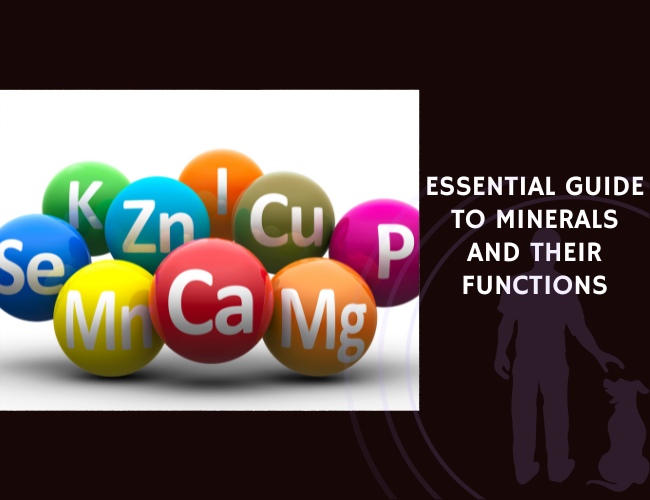Understanding Minerals in Canine Nutrition
Definition and Importance of Minerals in Dog Health
Minerals are inorganic elements that play crucial roles in various physiological functions within a dog’s body. Unlike vitamins, which are organic compounds, minerals do not degrade over time, making them consistently stable components in the diet. They are indispensable for the maintenance of skeletal structure, nerve function, muscle contraction, and metabolic processes. Inadequate or excessive mineral intake can lead to a myriad of health issues, ranging from skeletal deformities to impaired immune function.
Classification into Macrominerals and Trace Minerals
Minerals in canine nutrition are classified into two categories: macrominerals and trace minerals. This classification is based on the quantity required by the body:
- Macrominerals: These are required in larger amounts and include elements such as calcium, phosphorus, magnesium, sodium, potassium, and chloride.
- Trace Minerals: These are needed in smaller quantities and include iron, zinc, copper, manganese, iodine, and selenium.
Despite their relatively small required quantities, trace minerals are just as crucial as macrominerals for balanced health.
How Minerals Are Measured in Pet Food (Ash Component Analysis)
When assessing the mineral content in pet food, an important term that is often mentioned is “ash.” The ash content represents the total mineral content and is determined through a process known as ash component analysis. This technique involves burning the organic material in the food at high temperatures until only inorganic residue (ash) remains. This residue contains all the essential minerals present in the food. Ash analysis helps nutritionists ensure that pet foods meet the required mineral levels and balance necessary for optimal health.
Minerals are quantified in terms of parts per million (ppm) or percentages, depending on the mineral in question. This precise measurement is critical to avoid the risks associated with both deficiencies and excesses.
By understanding the foundational aspects of minerals in canine nutrition, caregivers can make more informed decisions regarding their pets’ diet, ensuring a balanced intake of these vital nutrients.
Transitioning from the basics of mineral importance, the next logical step is to delve deeper into the specifics of essential macrominerals and their roles in a dog’s health.
Essential Macrominerals
Macrominerals, which include calcium, phosphorus, magnesium, sodium, potassium, and chloride, are vital for dogs’ health and need to be consumed in larger amounts compared to trace minerals. These minerals support various physiological functions such as skeletal structure, nerve functionality, muscle contraction, and metabolic processes.
Overview of Macrominerals
Calcium
Calcium is fundamental for bone and teeth health, blood clotting, muscle contraction, and nerve signaling. Insufficient calcium can lead to bone disorders such as rickets in puppies or osteoporosis in older dogs. Too much calcium, on the other hand, can lead to an imbalance in other nutrients.
Phosphorus
Phosphorus complements calcium in bone formation and energy production. It is also essential for the formation of the cellular membranes and genetic material. The calcium-to-phosphorus ratio in the diet must be balanced, typically around 1.2:1, to ensure proper bone health.
Magnesium
Magnesium supports over 300 enzymatic reactions, including energy production, synthesis of nucleic acids and proteins, and regulation of muscle and nerve functions. Deficiency in magnesium can lead to muscle weakness and poor growth.
Sodium
Sodium is necessary for maintaining fluid balance, regulating blood pressure, and transmitting nerve impulses. While sodium is essential, its excessive intake can lead to hypertension and other cardiovascular issues.
Potassium
Potassium is crucial for proper muscle function, nerve transmission, and heart health. It regulates fluid balance and helps to prevent hypokalemia, which can manifest as muscle weakness and heart dysfunction.
Chloride
Chloride, often paired with sodium, plays a pivotal role in maintaining fluid balance and creating the stomach’s hydrochloric acid, essential for digestion. Deficiency in chloride can lead to impaired digestion and metabolic alkalosis.
Required Quantities in Dog Diet
The nutritional requirements for these macrominerals vary depending on the dog’s life stage, size, and health status. Here are the general dietary recommendations:
- Calcium: 1-2% of dry matter
- Phosphorus: 0.5-1% of dry matter
- Magnesium: 0.06-0.1% of dry matter
- Sodium: 0.2-0.4% of dry matter
- Potassium: 0.6-0.8% of dry matter
- Chloride: 0.2-0.35% of dry matter
These values are derived from guidelines established by organizations such as the National Research Council (NRC) and the Association of American Feed Control Officials (AAFCO).
Sources of Macrominerals in Commercial Dog Food
Commercial dog foods are formulated to meet the macromineral needs of dogs, utilizing a variety of ingredients to provide these essential nutrients:
- Calcium: Sourced from bone meal, fish meal, and dairy products.
- Phosphorus: Sourced from meat, fish, poultry, and bone meal.
- Magnesium: Found in leafy green vegetables, nuts, seeds, and whole grains.
- Sodium: Added as sodium chloride (salt) and naturally present in meats.
- Potassium: Present in meats, vegetables, fruits, and grains.
- Chloride: Primarily added through sodium chloride (salt) for balancing purposes.
As these macrominerals are included in commercial dog foods, it’s crucial to check the ingredient list and guaranteed analysis labels to ensure a balanced intake. Monitoring the dog’s overall diet and consulting with a veterinarian can prevent potential imbalances.
Understanding the role and sources of macrominerals is essential for maintaining a healthy and balanced diet for dogs. Effective diet planning involves the careful consideration of macrominerals to ensure all nutritional needs are met.
Critical Trace Minerals
Trace minerals, also known as microminerals, play indispensable roles in canine health despite being required in much smaller quantities compared to macrominerals. The most important trace minerals for dogs include iron, zinc, copper, manganese, iodine, and selenium. Each of these elements must be carefully balanced within the diet to prevent both deficiencies and toxicities, as symptoms of imbalance can negatively impact a dog’s health.
Introduction to Essential Trace Minerals
Iron
Iron is critical for the formation of hemoglobin, which is responsible for oxygen transport in the blood. A deficiency in iron can lead to anemia, characterized by lethargy, weakness, and pale gums. Conversely, an excess of iron can cause gastrointestinal issues and damage internal organs.
Zinc
Zinc is important for immune function, skin health, and wound healing. Inadequate zinc levels can result in dermatitis, impaired growth, and a weakened immune response. Over-supplementation can inhibit the absorption of other essential minerals, leading to secondary deficiencies.
Copper
Copper assists in the production of red blood cells, connective tissue, and the absorption of iron. Deficiency symptoms include anemia, poor bone health, and depigmentation of hair. An excess of copper, however, can lead to liver damage and gastrointestinal distress.
Manganese
Manganese supports bone development, cartilage formation, and enzymatic functions. A lack of manganese can cause skeletal abnormalities, such as reduced bone density and issues with joint health. High levels of manganese are typically less common but can interfere with the absorption of other vital minerals.
Iodine
Iodine is essential for the production of thyroid hormones, which regulate metabolism. Deficiency in iodine can cause hypothyroidism, exhibiting symptoms like weight gain, lethargy, and hair loss. Excess iodine can also disrupt thyroid function, causing hyperthyroidism or other thyroid-related disorders.
Selenium
Selenium works in conjunction with vitamin E to protect cells from oxidative damage. It’s also involved in thyroid hormone metabolism. Selenium deficiency can result in muscle weakness and reproductive issues, while toxicity can cause flakiness of the coat, fatigue, and in severe cases, neurological symptoms.
Importance of Proper Dosage and Balance
Maintaining the appropriate levels of each trace mineral is crucial for optimal health in dogs. The delicate balance is necessary because both shortages and surpluses pose health risks. Pet owners should consult with veterinarians to ensure dietary formulations meet these balance requirements, particularly when preparing homemade diets.
Symptoms of Deficiency and Excess
Recognizing the signs of mineral imbalances can prevent long-term health issues. Here are general symptoms to watch for:
- Deficiency Symptoms:
- Iron: Pale gums, lethargy, weakness
- Zinc: Skin issues, poor growth, weakened immune system
- Copper: Anemia, bone health issues, hair discoloration
- Manganese: Skeletal deformities, joint issues
- Iodine: Weight gain, lethargy, hair loss
- Selenium: Muscle weakness, reproductive problems
- Excess Symptoms:
- Iron: Gastrointestinal issues, organ damage
- Zinc: Inhibited absorption of other minerals
- Copper: Liver damage, gastrointestinal distress
- Manganese: Mineral absorption interference (less common)
- Iodine: Thyroid dysfunction
- Selenium: Coat flakiness, fatigue, neurological issues
Feeding dogs a balanced and varied diet, whether through high-quality commercial dog foods or carefully crafted homemade recipes, is essential to meet their trace mineral requirements. Monitoring and adjusting their diet according to life stages and health status ensures they receive the right amount of nutrients.
By understanding the roles and required balances of these critical trace minerals, pet owners can help maintain their dogs’ overall health and wellbeing.
Physiological Roles of Minerals
Minerals play an essential role in maintaining various physiological functions in dogs, contributing to their overall health and well-being. Understanding these roles helps in ensuring that dogs receive a balanced diet tailored to their needs.
Role in Bone and Teeth Development
One of the primary functions of minerals is in the development and maintenance of bones and teeth. Calcium and phosphorus are the two dominant minerals involved in this process. Together, they form a crystalline structure in bones, providing strength and stability. Calcium is also crucial for the proper mineralization of teeth, ensuring they remain hard and functional. An imbalance, such as excess phosphorus and insufficient calcium, can lead to conditions like rickets or osteomalacia, particularly in growing puppies.
Magnesium plays a supporting role by contributing to bone matrix formation. It assists in controlling calcium homeostasis, which is vital for healthy bones. Without adequate magnesium, calcium metabolism is disrupted, potentially leading to skeletal deformations and weakened bone structures.
Function in Muscle Contraction and Nerve Transmission
Minerals are indispensable for muscle contraction and nerve function. Sodium, potassium, and calcium work together to maintain the electrical gradients across cell membranes, which is critical for muscle contractions and nerve impulse transmission.
- Sodium and Potassium: These electrolytes are involved in creating nerve impulses. Sodium enters cells when a nerve signal is generated, while potassium exits, resetting the cells’ balance. This exchange allows for muscle contractions and nerve signaling.
- Calcium: Acts as a critical regulator in muscle contractions. When a nerve signal reaches a muscle, calcium is released inside muscle cells, facilitating the interaction of actin and myosin, the proteins responsible for muscle contraction.
Much like a delicately balanced symphony, any disruption in these mineral levels can lead to muscle weakness, cramps, or more severe health issues like hyperkalemia (high potassium levels) or hyponatremia (low sodium levels).
Importance in Enzymatic Reactions and Metabolism
Minerals act as catalysts in numerous enzymatic reactions and metabolic processes. These reactions are crucial for sustaining life and maintaining health.
- Enzymatic Reactions: Trace minerals like zinc, copper, and manganese serve as cofactors for enzymes, assisting in various biochemical reactions. For example, zinc is essential for DNA synthesis and immune response, while copper is involved in the production of hemoglobin and collagen.
- Iron: Vital for producing hemoglobin, the molecule in red blood cells that transports oxygen throughout the body. Iron deficiency can result in anemia, characterized by fatigue and poor immune function.
- Chromium and Manganese: Play roles in carbohydrate metabolism. Chromium enhances insulin action, helping regulate blood glucose levels, while manganese is involved in energy production and the synthesis of fatty acids.
Minerals are integral to metabolism, affecting processes such as protein synthesis, hormone regulation, and energy production. Proper mineral balance ensures that these processes function optimally, contributing to the health and vitality of dogs.
Understanding the physiological roles of minerals highlights the importance of providing a balanced diet to maintain these functions. The intricate interplay of these minerals underscores their necessity for sustaining the health and well-being of dogs.
Acid-Base Balance
Minerals play an essential role in maintaining the acid-base balance in a dog’s body. This balance is critical for ensuring proper organ function and overall health. When there are imbalances, such as acidosis (high acidity) or alkalosis (high alkalinity), it can lead to serious health issues like organ damage and decreased muscle function. This chapter will explore how dietary minerals influence acid-base balance, the impact of feeding patterns on mineral absorption, and the role of bones as mineral reserves and pH buffers.
How Dietary Minerals Affect Acid-Base Balance
Dietary minerals such as sodium, potassium, and chloride are key players in regulating acid-base balance. Each of these minerals has distinct roles:
- Sodium (Na+): Essential for regulating blood volume, blood pressure, and osmotic equilibrium. It works with chloride to form sodium chloride (salt), which is pivotal in maintaining extracellular fluid balance.
- Potassium (K+): Vital for maintaining intracellular fluid balance, muscle function, and nerve conduction. Higher levels of potassium are associated with a more alkaline state within the body.
- Chloride (Cl-): Works with sodium to regulate fluid balance and is necessary for producing hydrochloric acid in the stomach, contributing to the acidic environment essential for digestion.
These minerals act as electrolytes, conducting electrical impulses that enable various bodily functions. Maintaining the right balance of these minerals in the dog’s diet helps ensure an appropriate pH level, which should be around 7.4 for most bodily fluids.
Impact of Feeding Patterns on Mineral Absorption
Feeding patterns can significantly influence the absorption of minerals and the maintenance of acid-base balance. Factors that affect mineral absorption include:
- Meal Frequency and Size: Smaller, more frequent meals can improve absorption rates for minerals and help maintain a more stable pH balance.
- Food Composition: The presence of particular nutrients can either enhance or inhibit the absorption of minerals. For example, high dietary fiber can reduce mineral absorption, whereas foods high in protein can increase the body’s acid load, requiring a balance with alkaline minerals like potassium.
- Timing of Meals: Synchronizing meal times with the dog’s circadian rhythm can optimize digestion and absorption. Offering meals at consistent times each day helps regulate metabolic processes and acid production.
Feeding practices tailored to a dog’s individual needs, such as activity levels, age, and health status, will support better absorption and overall health.

Role of Bones as Mineral Reserves and pH Buffers
Bones not only provide structural support but also serve as a significant reserve for minerals. Calcium, magnesium, and phosphorus are stored in the bones and can be mobilized when needed to maintain acid-base balance.
During periods of acidosis, the body can draw calcium and phosphate from bones to act as bases and neutralize excess acid. Conversely, in situations where there is an excess of base (alkalosis), bones can deposit more minerals to help maintain the balance. This process underscores the importance of a well-balanced diet that consistently supplies these essential minerals to avoid depleting the skeletal reserves.
Understanding these underlying principles ensures that caregivers can provide their dogs with diets that support optimal health. Making informed dietary choices will contribute to maintaining internal stability and preventing health issues related to mineral imbalances.
By focusing on maintaining a balanced diet and proper feeding practices, dog owners can support their pet’s well-being and mitigate risks associated with acid-base imbalances.
Feeding Guidelines and Best Practices
Recommended Feeding Schedules for Optimal Mineral Absorption
Proper feeding schedules play a crucial role in ensuring that a dog’s body effectively absorbs essential minerals. Feeding times should be consistent, as dogs thrive on routine. Dividing the daily ration into two or three smaller meals instead of one large meal can enhance nutrient absorption. This method helps to maintain balanced blood mineral levels and prevent digestive issues, facilitating a steady intake and absorption of necessary minerals.
For example, morning feeding can kickstart the dog’s metabolic processes, while an evening meal can assist in maintaining energy levels and supporting metabolic functions during rest. Puppies, pregnant or lactating females, and working dogs may require more frequent feedings due to their higher nutritional demands.
Balancing Mineral Intake Through Diet Selection
Choosing the right commercial dog food that meets your pet’s specific nutritional needs is essential. High-quality commercial dog foods are often formulated to provide a balanced mix of macrominerals and trace minerals. It is vital to select a food that lists specific sources of minerals on the ingredient panel, such as bone meal for calcium and phosphorus, or fish for iodine and selenium.
When selecting dog food, consider the following tips:
- Check for AAFCO Approval: Choose foods that meet the Association of American Feed Control Officials (AAFCO) nutritional guidelines. These foods are formulated to ensure a balance of nutrients, including essential minerals.
- Ingredient Quality: Opt for foods with clearly labeled ingredients and avoid those with generic terms like “meat meal” or “animal by-products.”
- Life Stage Formulation: Ensure the food meets the nutritional needs of your dog’s life stage, whether they are a puppy, adult, senior, pregnant or nursing dog.
It’s important to note that home-prepared diets might require supplementation to meet the complete mineral requirements. Consulting with a veterinarian or a pet nutritionist can help create a balanced plan that avoids deficiencies or excesses.
Monitoring and Maintaining Proper Mineral Levels
Regular monitoring of your dog’s mineral levels is necessary to maintain optimal health. Periodic veterinary check-ups, including blood tests, can help detect imbalances early. Symptoms of mineral deficiencies can vary widely, from lethargy and poor coat quality to bone deformities and cognitive issues. Conversely, mineral excesses can lead to toxicity symptoms, including vomiting, diarrhea, and organ damage.
Consider the following practices:
- Keep Records: Maintain detailed records of your dog’s diet, health issues, and any changes in behavior or physical condition. This information can be crucial for your vet in making dietary adjustments.
- Regular Health Checks: Schedule routine vet visits for thorough health evaluations, including blood and urine tests to monitor mineral levels.
- Stay Informed: Educate yourself on the symptoms of mineral imbalances. Awareness allows for prompt action and adjustment of your pet’s diet.
Ensuring that your dog receives the proper balance of minerals through a thoughtfully selected diet and regimented feeding schedule is fundamental to their health and well-being. Regular monitoring and consultation with professionals will further support maintaining the appropriate mineral levels for your pet, fostering a long and healthy life.
In the next discussion, we will delve deeper into another crucial aspect of canine nutrition.









